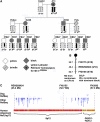Linkage and segregation analysis of black and brindle coat color in domestic dogs
- PMID: 17483404
- PMCID: PMC1931550
- DOI: 10.1534/genetics.107.074237
Linkage and segregation analysis of black and brindle coat color in domestic dogs
Abstract
Mutations of pigment type switching have provided basic insight into melanocortin physiology and evolutionary adaptation. In all vertebrates that have been studied to date, two key genes, Agouti and Melanocortin 1 receptor (Mc1r), encode a ligand-receptor system that controls the switch between synthesis of red-yellow pheomelanin vs. black-brown eumelanin. However, in domestic dogs, historical studies based on pedigree and segregation analysis have suggested that the pigment type-switching system is more complicated and fundamentally different from other mammals. Using a genomewide linkage scan on a Labrador x greyhound cross segregating for black, yellow, and brindle coat colors, we demonstrate that pigment type switching is controlled by an additional gene, the K locus. Our results reveal three alleles with a dominance order of black (K(B)) > brindle (k(br)) > yellow (k(y)), whose genetic map position on dog chromosome 16 is distinct from the predicted location of other pigmentation genes. Interaction studies reveal that Mc1r is epistatic to variation at Agouti or K and that the epistatic relationship between Agouti and K depends on the alleles being tested. These findings suggest a molecular model for a new component of the melanocortin signaling pathway and reveal how coat-color patterns and pigmentary diversity have been shaped by recent selection.
Figures




Similar articles
-
Exclusion of melanocortin-1 receptor (mc1r) and agouti as candidates for dominant black in dogs.J Hered. 2003 Jan-Feb;94(1):75-9. J Hered. 2003. PMID: 12692166
-
Characterization of the dog Agouti gene and a nonagoutimutation in German Shepherd Dogs.Mamm Genome. 2004 Oct;15(10):798-808. doi: 10.1007/s00335-004-2377-1. Mamm Genome. 2004. PMID: 15520882
-
Genetic variation within coat color genes of MC1R and ASIP in Chinese brownish red Tibetan pigs.Anim Sci J. 2010 Dec;81(6):630-4. doi: 10.1111/j.1740-0929.2010.00789.x. Epub 2010 Oct 7. Anim Sci J. 2010. PMID: 21108681
-
Melanocortin receptors and antagonists regulate pigmentation and body weight.Bioessays. 1998 Aug;20(8):603-6. doi: 10.1002/(SICI)1521-1878(199808)20:8<603::AID-BIES1>3.0.CO;2-J. Bioessays. 1998. PMID: 9780833 Review.
-
Red hair--a desirable mutation?J Cosmet Dermatol. 2002 Jul;1(2):62-5. doi: 10.1046/j.1473-2165.2002.00036.x. J Cosmet Dermatol. 2002. PMID: 17147521 Review.
Cited by
-
60 YEARS OF POMC: Regulation of feeding and energy homeostasis by α-MSH.J Mol Endocrinol. 2016 May;56(4):T157-74. doi: 10.1530/JME-16-0014. Epub 2016 Mar 3. J Mol Endocrinol. 2016. PMID: 26939593 Free PMC article. Review.
-
Genome sequencing of 2000 canids by the Dog10K consortium advances the understanding of demography, genome function and architecture.Genome Biol. 2023 Aug 15;24(1):187. doi: 10.1186/s13059-023-03023-7. Genome Biol. 2023. PMID: 37582787 Free PMC article.
-
True Colors: Commercially-acquired morphological genotypes reveal hidden allele variation among dog breeds, informing both trait ancestry and breed potential.PLoS One. 2019 Oct 28;14(10):e0223995. doi: 10.1371/journal.pone.0223995. eCollection 2019. PLoS One. 2019. PMID: 31658272 Free PMC article.
-
Five genetic variants explain over 70% of hair coat pheomelanin intensity variation in purebred and mixed breed domestic dogs.PLoS One. 2021 May 27;16(5):e0250579. doi: 10.1371/journal.pone.0250579. eCollection 2021. PLoS One. 2021. PMID: 34043658 Free PMC article.
-
Elucidation of Melanogenesis Cascade for Identifying Pathophysiology and Therapeutic Approach of Pigmentary Disorders and Melanoma.Int J Mol Sci. 2020 Aug 25;21(17):6129. doi: 10.3390/ijms21176129. Int J Mol Sci. 2020. PMID: 32854423 Free PMC article. Review.
References
-
- Aigner, B., U. Besenfelder, M. Muller and G. Brem, 2000. Tyrosinase gene variants in different rabbit strains. Mamm. Genome 11: 700–702. - PubMed
-
- Andersson, L., 2003. Melanocortin receptor variants with phenotypic effects in horse, pig, and chicken. Ann. NY Acad. Sci. 994: 313–318. - PubMed
-
- Barsh, G. S., 2006. Regulation of pigment type-switching by Agouti, Melanocortin signaling, Attractin, and Mahoganoid, pp. 395–410 in The Pigmentary System, edited by J. J. Nordlund, R. E. Boissy, V. J. Hearing, R. A. King, W. S. Oetting and J. P. Ortonne. Blackwell, Oxford.
-
- Barton, N. H., and P. D. Keightley, 2002. Understanding quantitative genetic variation. Nat. Rev. Genet. 3: 11–21. - PubMed
-
- Berryere, T. G., J. A. Kerns, G. S. Barsh and S. M. Schmutz, 2005. Association of an Agouti allele with fawn or sable coat color in domestic dogs. Mamm. Genome 16: 262–272. - PubMed
Publication types
MeSH terms
Substances
LinkOut - more resources
Full Text Sources
Other Literature Sources

